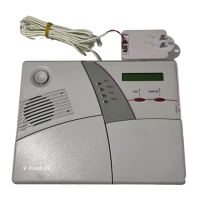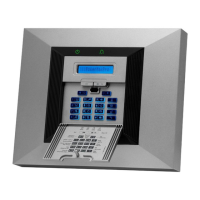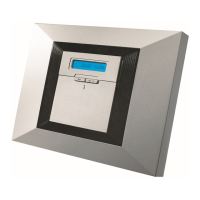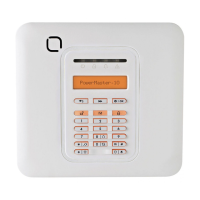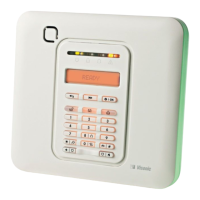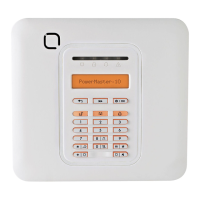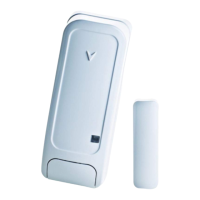D-303973 PowerMaxExpress Installer's Guide 19
Figure 4.4 - DEFINE PANEL Flow Chart
4.5 DEFINING COMMUNICATION PARAMETERS
Preliminary Guidance
This mode allows you to adapt the telephone
communication parameters to the local requirements.
Compatible central station receivers are:
Osborne-Hoffman model 2000, Ademco Model 685,
FBII Model CP220, Radionics Model D6500, Sur-Gard
Model SG-MLR2-DG and Silent Knight Model 9500.
IMPORTANT: In telephone / pager number locations and
account number locations, you may be required to enter
hexadecimal digits. In telephone number locations, these
digits are used as codes to control the dialer:
4.5.1 PSTN / GSM (Fig. 4.5 Detail A)
Area Code [Fig 4.5.1(1)]
Here you enter the system tel. area code (up to 4 digits).
Line Prefix [Fig 4.5.1(2)]
Here you enter the number that is used as a prefix to
access an outside telephone line (if exists).
Dial Method [Fig 4.5.1(3)]
Here you determine the dialing method used by the
automatic dialer built into the PowerMaxExpress control
panel.
The options are: Pulse and tone (dtmf).
GSM Keep Alive [Fig 4.5.1(4)]
Here you prevent the GSM service provider from
disconnecting the GSM line if the user has not initiated any
outgoing telephone calls during the last 28 days.
The options are: disable and every 28 days.
4.5.2 GPRS / BB [Fig. 4.5 Detail B]
The GSM/GPRS module is capable of communicating with
the Central Station receiver by GPRS, GSM Voice and
SMS channels. Each of the channels can be separately
enabled or disabled in order to allow or prohibit the module
from using it for the event reporting. If all channels are
enabled, the GSM/GPRS module will always try GPRS
first. If fails, it will try GSM Voice. If fails, it will try any other
possible method (PSTN, Broadband) and only then it will
try SMS. This is due to the fact that SMS is the most
unreliable option of communication. Disabling any of the
GSM Module channels will cause the module to use a
different sequence than the one described above.
GPRS Report [Fig 4.5.2(1)]
Here you determine whether the alarm system will report
events to the central station via the GPRS channel.
The options are: disable and enable.
GSM Report [Fig 4.5.2(2)]
Here you determine whether the alarm system will report
events to the central station via the GSM voice channel.
The options are: disable and enable.
SMS Report [Fig 4.5.2(3)]
Here you determine whether the alarm system will report
events to the central station via the SMS channel.
The options are: disable and enable.
GPRS APN [Fig 4.5.2(4)]
Here you enter the name of the APN (Access Point) used for
the internet settings for the GPRS (up to 40 digits).

